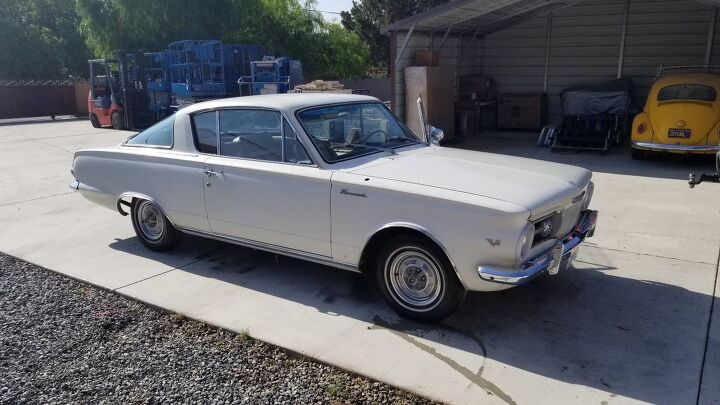Rare Rides: Ooh Barracuda - the Fastback Plymouth From 1965

Today’s Rare Ride is a Plymouth Barracuda, but not the one which generally springs to mind whenever someone mentions the legendary nameplate. Rather, it’s the first of the line. Let’s check out this special fastback.
Budget in mind, Chrysler turned to designer Irv Ritchie, telling him to see what he could do with the existing Valiant chassis. Mr. Ritchie drafted up a fastback Valiant. The top brass at Plymouth liked the new design, and planned to use the very aggressive name Panda for their new car. Designers frowned at this, and the Barracuda name was selected instead.
The new Barracuda coupe was ready in 1964, debuting on April Fool’s Day. Most of the front panels were shared with the Valiant, but a new trunk and rear glass area was required to pull off the Barracuda’s unique greenhouse. The fabrication of the rear glass was one of the most costly parts of the Barracuda’s development, as the window measured 14.4 square feet. Chrysler worked with PPG to develop the window, which at the time was the largest window ever installed in a production car. The Barracuda went on sale two weeks before Ford’s Mustang.
Perhaps unsurprisingly, the Barracuda’s power matched that of the Valiant. Two different inline-six engines were available, in either 2.8- or 3.7-liters of displacement, with 101 or 145 horsepower, respectively. The upmarket engine offering was the 180 horsepower 4.5-liter Commando V8, a new engine for that year. Transmission options included a four-speed manual or three-speed TorqueFlite automatic.
Chrysler added more performance and sporting elements in the two years following the Barracuda’s introduction as Ford and General Motors dove deeper into the intensifying pony car market. After the 1965 model year, the Valiant badge disappeared from the Barracuda entirely. At the same time, the V on the rear (which previously stood for Valiant) became a Barracuda fish logo.
The original fastback version of the Barracuda bowed out after 1966, replaced by a second-generation model that further differentiated itself from its Valiant stablemate. The stage was set for Barracuda to become a separate model in its own right.
Today’s V8-powered Rare Ride comes to us from east of Los Angeles, which is in California. It asks $12,000, has 61,000 miles on the odometer, and pairs white paint with a gold interior.
[Images: seller]

Interested in lots of cars and their various historical contexts. Started writing articles for TTAC in late 2016, when my first posts were QOTDs. From there I started a few new series like Rare Rides, Buy/Drive/Burn, Abandoned History, and most recently Rare Rides Icons. Operating from a home base in Cincinnati, Ohio, a relative auto journalist dead zone. Many of my articles are prompted by something I'll see on social media that sparks my interest and causes me to research. Finding articles and information from the early days of the internet and beyond that covers the little details lost to time: trim packages, color and wheel choices, interior fabrics. Beyond those, I'm fascinated by automotive industry experiments, both failures and successes. Lately I've taken an interest in AI, and generating "what if" type images for car models long dead. Reincarnating a modern Toyota Paseo, Lincoln Mark IX, or Isuzu Trooper through a text prompt is fun. Fun to post them on Twitter too, and watch people overreact. To that end, the social media I use most is Twitter, @CoreyLewis86. I also contribute pieces for Forbes Wheels and Forbes Home.
More by Corey Lewis
Latest Car Reviews
Read moreLatest Product Reviews
Read moreRecent Comments
- MaintenanceCosts If only it had a hatch. The Model S is so much more practical, has similar performance in non-Plaid form, and is $20k more - and the $20k premium seems almost worth it just for the hatch.
- Lorenzo I'm not surprised. They needed to drop the "four-door coupe", or as I call it, the Dove soap bar shape, and put a formal flat roof over the rear seats, to call it a sedan. The Legacy hasn't had decent back seat headroom since the 1990s, except for the wagons. Nobody wants to drive with granny in the front passenger seat!
- Analoggrotto GM is probably reinventing it as their next electric.
- Vatchy What is the difference between a car dealer and a drug dealer? Not much - you can end up dead using what they sell you. The real difference is that one is legal and one is not.
- Theflyersfan Pros: Stick shift, turbo wagonExtra tires and wheelsBody is in decent shape (although picture shows a little rust)Interior is in decent shapeService records so can see if big $$$ is coming upCan handle brutal "roads" in Uganda, Rwanda, and Tanzania, although the spare wheels and tires will be needed. (See picture)Cons:Mileage is high Other Volvos on the site are going for less moneyAnyone's guess what an Ontario-driven in the winter vehicle looks like on the lift.Why wasn't the interior cleaned?Clear the stability control message please...Of course it needs to cross the border if it comes down here. She lowers the price a bit and this could be a diamond in the rough. It isn't brown and doesn't have a diesel, but this checks most TTAC wagon buyer boxes!







































Comments
Join the conversation
A Heart fan, I see. My dream has always been to get a 'cuda and keep this song at the ready on whatever sound system I've installed, just for stoplight encounters and Cars and Coffee.
This car does a lot to contextualize the AMC Marlin.